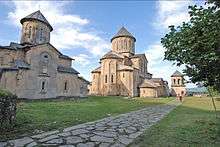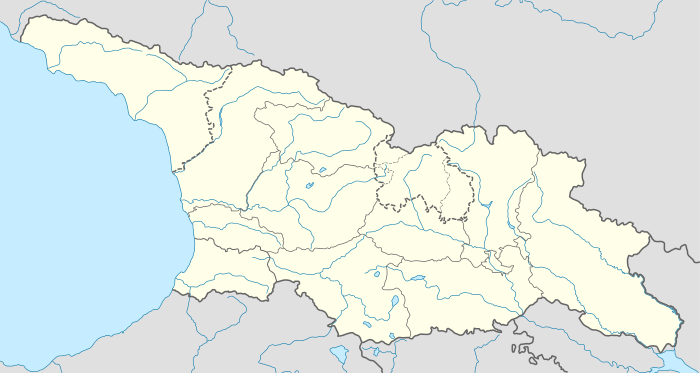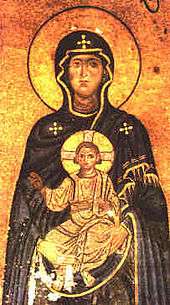Gelati Monastery
| Gelati Monastery გელათის მონასტერი | |
|---|---|
 The monastic complex of Gelati | |
 Shown within Georgia | |
| Basic information | |
| Location | Kutaisi, Imereti Province (Mkhare), Georgia |
| Geographic coordinates | 42°17′40″N 42°46′03″E / 42.2945472°N 42.7675583°ECoordinates: 42°17′40″N 42°46′03″E / 42.2945472°N 42.7675583°E |
| Affiliation | Georgian Orthodox Church |
| Region | Caucasus |
| Architectural description | |
| Architectural type | Georgian; Monastery |
| Founder | David IV of Georgia ("David the Builder") |
| Completed |
Church of the Virgin, 1106; Churches of St. George and St. Nicholas, 13th century |
| UNESCO World Heritage site | |
| Criteria | Cultural: iv |
| Reference | 710 |
| Inscription | 1994 (18th Session) |
| Endangered | 2010-2017 |
| Area | 4,2 ha |
| Buffer zone | 1,246 ha |
Gelati (Georgian: გელათის მონასტერი) is a medieval monastic complex near Kutaisi, in the Imereti region of western Georgia. A masterpiece of the Georgian Golden Age, Gelati was founded in 1106 by King David IV of Georgia and is recognized by UNESCO as a World Heritage Site.
The Gelati Monastery is in Kutaisi, Imereti Province, Georgia. It signifies the value of the Georgian christian orthodox religion. Inside the monastery is full of murals and an abundance amount imagery surrounding the interior of the church. It was one of the first monastery in Georgia and adds great value to the Georgian culture and beauty.
The nickname of The Gelati Monastery is the “Golden Age of Georgia”. The monastery was built during the byzantine empire which is known for the use of gold aesthetic in their paintings and buildings. It was built to show how christianity encompassed all of this land and that Georgia was filled with christian gospel all around even high up in the mountains. As the monastery is covered in arches that stretch over mountains show how encompassing the monastery is over the mountains and over the hills.
Overview
Historically, Gelati was one of the main cultural and intellectual centers in Georgia. It had an Academy that employed some of the most celebrated Georgian scientists, theologians and philosophers, many of whom had previously been active at various orthodox monasteries abroad, such as the Mangana Monastery in Constantinople. Among the religious authors were celebrated scholars as Ioane Petritsi and Arsen Ikaltoeli. Due to the extensive work carried out by the Gelati Academy, people of the time called it "a new Hellas" and "a second Athos".[1]
The Gelati Monastery has preserved a great number of murals and manuscripts dating back to the 12th to 17th centuries. The Khakhuli triptych was enshrined at Gelati until being stolen in 1859. Gelati is the burial site of its founder and one of the greatest Georgian kings David IV. Near King David's grave are the gates of Ganja, which were taken as a trophy by King Demetrius I of Georgia in 1138.
Landscape
The monastery is on top of a grassy hill that overlooks the old capital of Kutaisi. As it stands on top of the hill for all to see, it has a significant part to what the monastery represents, a way to be closer to god. The monastery encompases the atmosphere and how that balances the exterior architecture. It was designed to show the surrounding forest complimented the monastery in a god like way. On top of the hill as it overlooks the country field of Georgia right below the hill is the Tskaltsitela.
History
The Gelati Monastery was built in 1106 by King David IV of Georgia. It was constructed during the Byzantine empire, during which christianity was the ruling religion throughout the empire. The Monastery is known as Church of Virgin the Blessed, meaning that the church is dedicated to the virgin mary and her spiritual powers. Mary has a motherly component to her that shows the important factors to the virgin mary, mother to jesus christ. Overall, the church was not just used for religious purposes, it was also used to teach science. It became the academy of math and sciences in all of Georgia.
Present Day
The Monastery still oversees all of Georgia and still is a functioning church. Tourists come from all over to see this masterpiece. Since the Soviet Union the monastery has been listed in the Georgian National Register of Monuments. It is still being restored and is in the hands of UNESCO to protect it. All of the original parts of the monastery are still intact and are still able to function as a stable building.
The monastery still needs to be and is currently being worked on and restored. Before the UNESCO was able to protect it the mosaics were somewhat intact and the murals were in bad conditions. On the academy building, the roof was destroyed so the Georgian conservatory was able to build a roof on it and has been able to take care of the building and the whole monastery. The Georgian national register of monuments was able to put it on the protection and restoration list in 2006, protecting the monastery for the future.
Triptychs
The triptychs are a certain type of icons that were specific in form and in structure. These were popular during the Byzantine empire and were very specific to the Georgian culture. The triptychs represented another form of contribution to the church. Triptychs were a form of iconography for the congregation to show their love for Jesus his apostles.
Mosaics
As you walk inside the monastery you will be able to see one of larger mosaics in all of Georgia. They spread from wall to wall showing how the byzantines worshiped God, Jesus, and their royalty. When the mosaics were first restored they were in such bad shape that many of them could not be salvaged. When the mosaics were restored they were able to show the intense idealization of the monasteries worshipers. The Gelati monastery is still able to show how the mosaics depict how the byzantine christian ideology about the role of church and state together.
The mosaics inside the monastery is covered in classic byzantine art styles. Covered in gold, the Virgin Mary is holding a baby Jesus is the main masterpiece in the church. The Galeti mosaic is described as the centerpiece of Georgia. Right above the altar, it is the Virgin Mary is looking upon the crowd holding a wise baby Jesus.
Architecture
The Gelati monastery represents the byzantine architectural style with full archways and smooth stone. It was built so that the main monastery is designed to look like a cross. The cross is the symbol of Jesus’s crucifixion on the cross, which is the symbol of christianity. The monastery was built in a way so that it could be seen on top of the hill overlooking all of Georgia. The walls are filled with smooth stone to reflect the sun on the top of the hill. The archways fill the monastery all around even on the bell tower and the small building next to the monastery.
Burials
- Demetrius I of Georgia
- David IV of Georgia
- Solomon I of Imereti
- Solomon II of Imereti
- George III of Georgia
- Vakhtang II of Georgia
- Bagrat VI of Georgia
- George V of Georgia
- Alexander II of Imereti
- George of Chqondidi
- Tamar of Georgia
 Mother of God, mosaic fresco
Mother of God, mosaic fresco Archangel Michael, mosaic fresco
Archangel Michael, mosaic fresco The Ascension, mural
The Ascension, mural David IV of Georgia, mural
David IV of Georgia, mural.jpg)
- Gelati monastery, church of Virgin Mary the Blessed. Mural of Christ Pantokrator on ceiling of the central dome (12th century)

 Gelati monastery, Church of Virgin the Blessed. Mural on north wall. From left to right: Queen Rusudan, Prince Bagrat, King George II, Queen Helen, King Bagrat III of Imereti, Catholicos Yevdemon Chetidze, David the Builder
Gelati monastery, Church of Virgin the Blessed. Mural on north wall. From left to right: Queen Rusudan, Prince Bagrat, King George II, Queen Helen, King Bagrat III of Imereti, Catholicos Yevdemon Chetidze, David the Builder Gelati monastery. Church of Virgin the Blessed. Mural.
Gelati monastery. Church of Virgin the Blessed. Mural.- Shrine in the monastery church
 Gelati Monastery
Gelati Monastery.jpg) Gelati Monastery
Gelati Monastery.jpg) Gelati Monastery
Gelati Monastery Gelati Monastery
Gelati Monastery Gelati Monastery
Gelati Monastery Gelati Monastery
Gelati Monastery.jpg) St. George church
St. George church.jpg) St. Nicholas church
St. Nicholas church.jpg) Belfry
Belfry.jpg) Cathedral of the Nativity of the Virgin
Cathedral of the Nativity of the Virgin.jpg) Portal in the cathedral
Portal in the cathedral.jpg) Frescoes in the cathedral
Frescoes in the cathedral.jpg) Frescoes in the cathedral
Frescoes in the cathedral
See also
References
- Byzantine Art, www.bourgogneromane.com/byzantine.htm.
- Centre, UNESCO World Heritage. “Gelati Monastery.” UNESCO World Heritage Centre, whc.unesco.org/en/list/710.
- Chichinadze, Nina. “Some Compositional Characteristics of Georgian Triptychs of the Thirteenth through Fifteenth Centuries.” Gesta, vol. 35, no. 1, 1996, pp. 66–76. JSTOR, JSTOR, www.jstor.org/stable/767227.
- Derlemenko I︠E︡vhen Anatoliĭovych, and Gigilashvili Ėduard. Gelati : Arkhitektura, Mozaika, Freski (Fotoalʹbom]= Gelati : Architecture, Mosaic, Frescoes. Tbilisi, Khelovneba, 1982.
- Hubert Kaufhold, Brill. Georgian Monasteries.
- Mepʻisašvili, R. Gelati. "Sabčotʻa Sakʻartʻvelo", 1965.
External links
Adapted from the Wikinfo article Gelati Monastery by Levan Urushadze, licensed under the GNU Free Documentation License.
| Wikimedia Commons has media related to Gelati Monastery. |